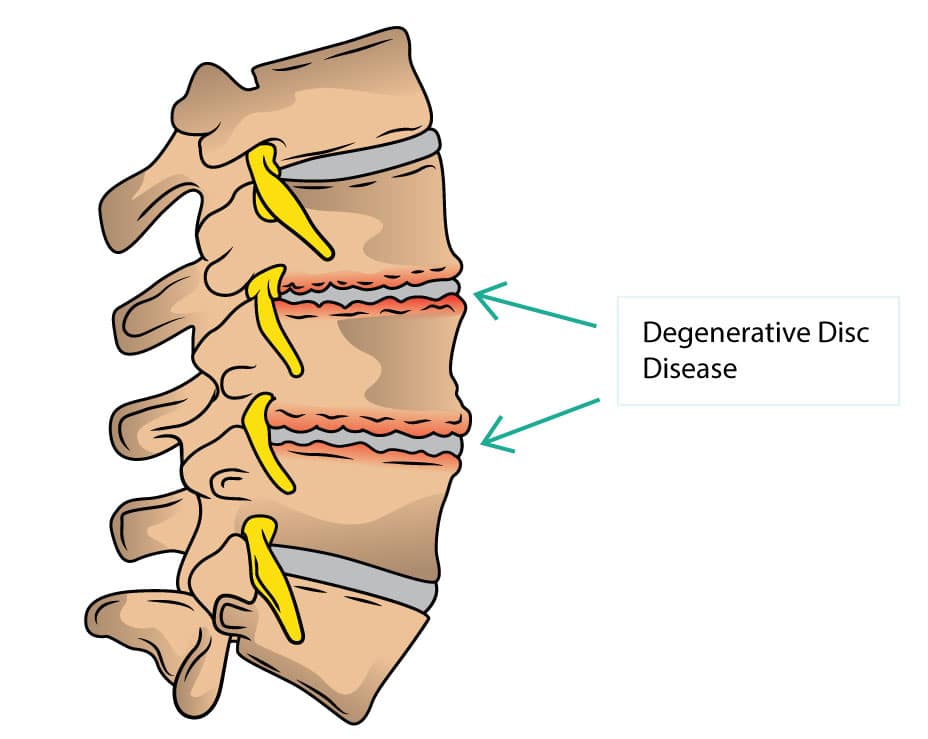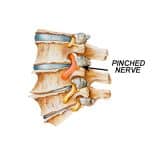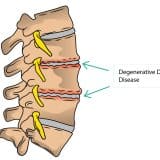Degenerative Disc Disease

Degenerative disc disease is the breaking down or deterioration of one or more than one disc, which are present between the vertebrae of your spinal column. It’s not a disease but develops naturally as you age. The discs present between your vertebrae are rubbery, which allows your back to bend and remain flexible, just like shock absorbers. But with aging, they start becoming worn out and cannot offer protection and flexibility.
Symptoms of degenerative disc disease
Disc degeneration, in some cases, does not show any symptoms, and in some, the pain becomes so intense that the person faces difficulty in their day-to-day activities. It usually starts with damage in the spine and slowly starts affecting other parts of your body and worsens as you age. Discomfort ranges generally from mild to severe, and sometimes, it is unbearable. It may also lead to osteoarthritis, with severe pain and stiffness in the back.
The earliest symptom is pain, weakness and numbness in the back, which start radiating to other areas. If the damage has occurred in the lower back or the lumbar spine, discomfort will radiate towards your buttocks and the upper thighs. Some other symptoms include tingling and numbness in one or both legs or feet.
When damage occurs in the neck area, the pain will spread to the hand, shoulder and arms. Sometimes, people experience spine instability, resulting in muscle spasms in the neck and lower back when your body tries to stabilize your vertebrae. Pain becomes worse while sitting, twisting, bending and lifting. Walking, altering position and lying down help in relieving pain.
What causes degenerative disc?
Intervertebral discs, also called spinal discs, offer the required padding between the spine’s vertebrae. It contains an elastic structure called fibrocartilage tissue. The external part of this disc is called annulus fibrosus, which is very tough and fibrous and has many overlapping layers. The disc’s inner core is soft and dense, called the nucleus pulposus.
The function of these discs is to cushion the stress whenever the spine makes any movement or tolerates weight. With increasing age, when stress also increases, and with some occasional injuries, the discs start suffering damage, which eventually causes degenerative discs.
Besides this, some other causes of degenerative disc disease are:
Fluid loss
The intervertebral disc of a healthy young person contains 90% fluid. As age increases, the fluid starts decreasing, thereby making the disc thin. Eventually, the distance between the vertebrae becomes smaller, and the discs become less efficient as shock absorber.
Structure of the disc
Very small tears sometimes appear in the external layer of the disc, and through these tears, the inner soft gel-like material starts seeping out. This results in a bulging disc, which starts breaking down into small fragments.
Bone spurs
When there is less padding between the vertebrae, the spine starts becoming less stable. To compensate, the body starts building osteophytes, also called bone spurs. Then, these bone spurs start pressing against the spinal nerve roots, which weakens the functioning of the nerves and cause pain.
Treatment
Treatment of degenerative discs mainly involves occasional therapy or physical therapy or sometimes both, along with exercise, weight loss and medications. Severe cases require surgical interventions.
For enquiries and online appointments:
Email – Naveen.st@gmail.com
Call/Whatsapp – +91 7676090119
Visit www.NaveenSpine.com to know more




